When we hear about prehistoric sea creatures, we often think of the giant sea monsters that once roamed the oceans. We believe that they are all extinct. In reality, few of them still exist as living fossils.
I will discuss 15 of the most interesting prehistoric sea animals in this article, from the Ammonites to Megalodon, Tylosaurus, and others.
15 Prehistoric Sea Creatures
Before you know the details of all 15 prehistoric sea creatures have a quick look at the chart.
| Prehistoric Sea Creatures | Interesting Facts |
| Ammonite | Ammonites are extinct cephalopods that lived 450 million years ago, and their shells can be found all over the world. They are known for their spiral shells resembling a tightly-coiled ram’s horn. |
| Basilosaurus | Although its name means “king lizard,” Basilosaurus was actually a prehistoric whale that lived about 40 million years ago. It measured up to 60 feet long and had a serpentine body shape. |
| Dunkleosteus | Dunkleosteus was a prehistoric fish that lived 360 million years ago, and it had the strongest bite force of any known vertebrate. Its jaws were made of bony plates that could slice through prey like scissors. |
| Elasmosaurus | Elasmosaurus was a type of plesiosaur that lived 80 million years ago, and it had an extremely long neck with over 70 vertebrae – more than any other known animal. |
| Frilled Shark | The frilled shark is a prehistoric shark that has remained virtually unchanged for 80 million years. It has a unique appearance with a long, eel-like body and a frilled collar around its head. |
| Helicoprion | Helicoprion was a prehistoric shark that lived 290 million years ago, and it had a bizarre spiral-shaped tooth whorl that scientists are still trying to understand. |
| Ichthyosaur | Ichthyosaurs were prehistoric marine reptiles that lived 150 million years ago, and they were the first animals to give birth to live young instead of laying eggs. |
| Kronosaurus | Kronosaurus was a prehistoric marine reptile that lived 120 – 90 million years ago, and it was one of the largest carnivorous reptiles to ever live, measuring up to 33 feet long. |
| Leedsichthys | Leedsichthys was a prehistoric fish that lived 150 – 140 million years ago, and it was one of the largest fish to ever live, measuring up to 50 feet long. |
| Liopleurodon | Liopleurodon was a type of plesiosaur that lived 160 million years ago, and it was one of the largest marine reptiles to ever live, measuring up to 23 feet long. |
| Megalodon | Megalodon was a prehistoric shark that lived 2.6 million years ago, and it was one of the largest predators to ever exist, measuring up to 60 feet long. |
| Mosasaurus | Mosasaurus was a prehistoric marine reptile that lived 145.5 – 66 million years ago, and it was one of the largest marine predators to ever exist, measuring up to 50 feet long. |
| Nothosaurus | Nothosaurus was a prehistoric marine reptile that lived 240 million years ago, and it was one of the first marine reptiles to evolve flippers for swimming. |
| Plesiosaur | Plesiosaurs were prehistoric marine reptiles that lived 215 – 66 million years ago, and they had long necks and four flippers that they used to swim through the water. |
| Tylosaurus | Tylosaurus was a prehistoric marine reptile that lived 85 million years ago, and it was one of the largest mosasaurs to ever exist, measuring up to 45 feet long. |
Ammonite
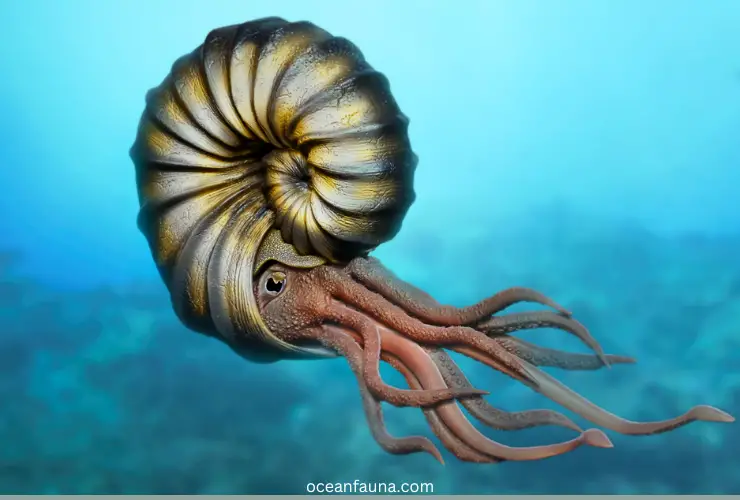
In our list, ammonite is the most diminutive prehistoric sea creature in the phylum Mollusca and the class Cephalopoda. They first appeared in the fossil record about 450 million years ago and flourished throughout the Mesozoic era.
They had distinctive coiled external shells that ranged from a few centimeters to more than two meters in diameter. The shell had intricate patterns and ridges that made them one of the most recognizable fossils in the world.
Ammonites were carnivorous animals that fed on other small marine creatures such as fish and crustaceans. They used sharp beaks to break their prey’s shells or cut through their soft bodies. Ammonites were also known to have tentacles that they used to grab hold of their prey.
The anatomy of ammonites was very similar to that of the modern-day nautilus. They had complex nervous systems and well-developed eyes, suggesting they could handle complex behaviors. Like other cephalopods, ammonites were also able to change their skin’s color and texture, allowing them to blend in with their surroundings and avoid predators.
The extinction of ammonites occurred at the end of the Cretaceous period, around 66 million years ago. Many scientists believe this was due to a catastrophic event, such as a meteor impact or volcanic eruption, that caused environmental changes that the ammonite could not adapt to.
Despite their extinction, ammonites left behind a rich fossil record that helps scientists better to understand the ancient marine ecosystems of the past.
Basilosaurus
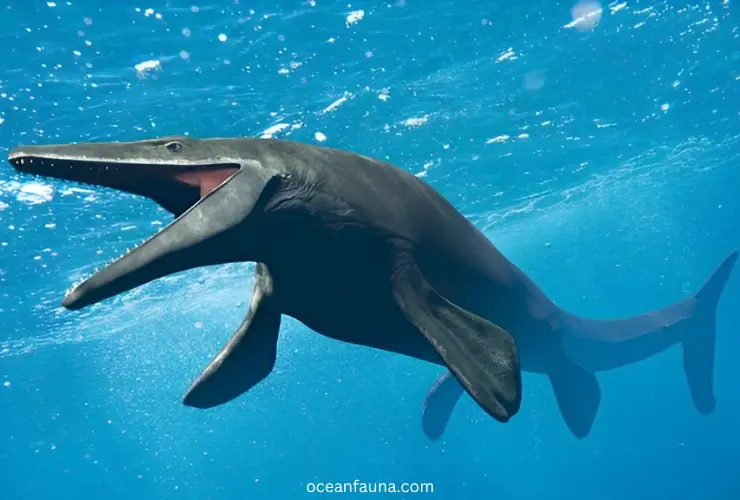
Basilosaurus, which means “king lizard,” was another prehistoric sea creature that existed approximately 40 to 34 million years ago during the Eocene period. It was a lengthy and serpentine animal, measuring up to 60 feet in length and weighing up to 15 tonnes. Although named after a lizard, Basilosaurus is not a reptile. Rather, it belongs to the extinct order Archaeoceti, which are early ancestors of modern-day whales.
Basilosaurus had a streamlined body, which allowed them to swim quickly through the water. It had a long, narrow snout filled with sharp teeth, which it used to catch fish and other small prey. Its limbs had evolved into flippers used for steering and maneuvering underwater.
Basilosaurus had a unique characteristic. Its spine was highly flexible and enabled it to swim like a serpent. Additionally, its internal organs were suited for diving as its rib cage could compress the lungs and it could travel deep into the waters.
Basilosaurus was an apex predator in its ecosystem, with no natural enemies other than possibly other members of its own species. It disappeared from the fossil record around 34 million years ago, possibly due to changing oceanic conditions and the emergence of new predators. However, its legacy lives on in the modern-day whales, which evolved from the same group of ancient whales as Basilosaurus.
Fossils of this creature have been discovered in rocks from the Middle and Late Eocene periods in North America and Northern Africa.
Dunkleosteus
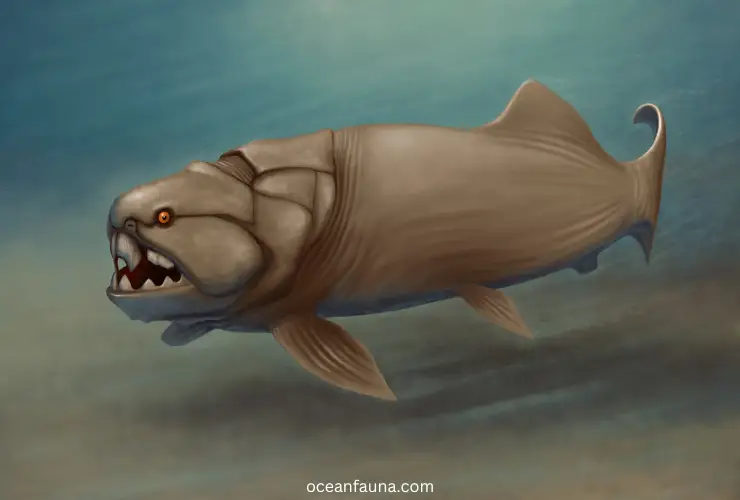
Dunkleosteus was a pelagic fish that lived approximately 358 to 382 million years ago in the late Devonian period. It was one of the largest and most fearsome predators of its time, growing up to 33 feet in length and weighing in at an estimated 4,000 pounds.
This ancient fish had a head that made up about one-third of its body length and was lined with sharp, bony plates that formed a large, powerful jaw. Its bite is said to have been one of the strongest of any vertebrate, with a crushing force of over 8,000 pounds per square inch.
Despite its massive size, Dunkleosteus was surprisingly agile and maneuverable in the water, thanks to its streamlined body and powerful fins. It likely preyed on a variety of other marine animals, including smaller fish and even other Dunkleosteus individuals.
Dunkleosteus is also known for its remarkably advanced eyes, which were among the first to have evolved in the animal kingdom. These eyes could swivel back and forth in their sockets, allowing the fish to track its prey with incredible accuracy.
Although Dunkleosteus disappeared from the world’s oceans around 360 million years ago, its legacy lives on in the fossil record. This prehistoric giant has been discovered through numerous fossils of various species found in North America, Poland, Belgium, and Morocco.
Elasmosaurus
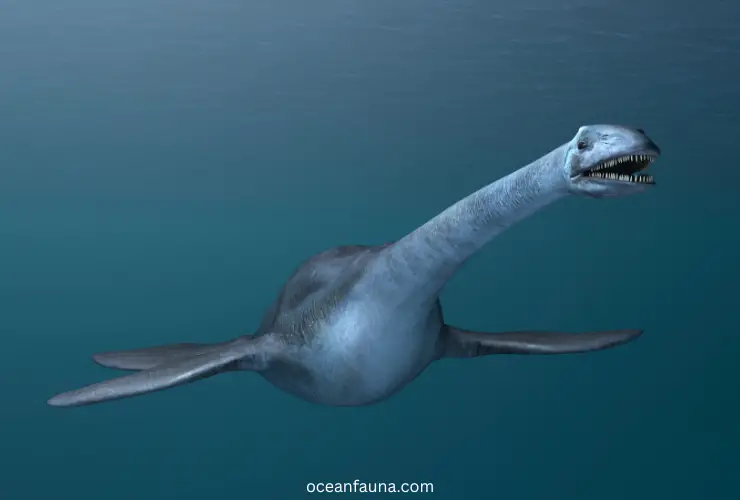
Approximately 80 million years ago, Elasmosaurus was present in North America during the Late Cretaceous period. The name Elasmosaurus is derived from “thin plate reptile” due to its slender and lengthy neck comprising over 70 vertebrae.
Elasmosaurus was a type of plesiosaur, which is a group of extinct marine reptiles that lived during the Mesozoic era. It was one of the largest plesiosaurs, measuring up to 43 feet (13 meters) in length. Its body was streamlined, and its four flippers were adapted for swimming in the open ocean.
One of the most distinctive features of Elasmosaurus was its length. The neck was believed to beck was used to catch prey, such as fish and squid, in the water column. The neck was also used to avoid predators, enabling the creature to maneuver rapidly away from danger.
Elasmosaurus was a carnivore with sharp teeth used to tear apart its prey. It also had excellent eyesight, which allowed it to spot prey from a distance.
Despite its large size and fearsome appearance, Elasmosaurus was not the apex predator of its time. It shared the ocean with other formidable creatures, such as giant sharks and marine reptiles like Ichthyosaurs.
Elasmosaurus became extinct around 66 million years ago, along with the dinosaurs and many other prehistoric animals. Its fossil record has provided valuable insights into the history and evolution of life on earth.
Frilled Shark
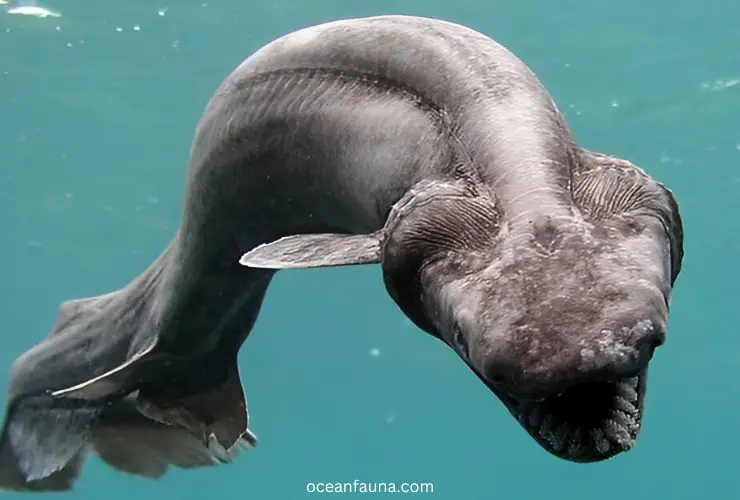
The Frilled shark, also called Chlamydoselachus anguineus, is a deep-sea shark that scientists call an “evolutionary relic.” This is because it has maintained the same physical appearance for over 80 million years, making it the only prehistoric creature in our list of sea creatures that still exist today. Its unique physical structure sets it apart from modern sharks and classifies it as a primitive species.
This shark has a distinct appearance: a slender and elongated body, a flattened head, and a mouth extending far behind the eyes. Its most striking feature is its frilled gills, which give it its name. The gills are not only for respiration but also play a crucial role in capturing prey.
The teeth of the Frilled shark are another remarkable feature. They are curved and backward-pointing, which makes it easier for the shark to hold on to its prey.
The Frilled shark is a deep-water species that can be found in the Atlantic, Pacific, and Indian Oceans. It typically inhabits depths between 50 and 1,500 meters, making studying extremely difficult. It is considered a rare species, and little is known about its behavior, reproduction, and other aspects of life.
The Frilled shark is a rare and intriguing creature that has fascinated people worldwide due to its elusive nature and unique features. It is often referred to as a “living fossil” and is a formidable predator in its natural environment.
Although it is not dangerous to humans, its status as a prehistoric sea creature continues to make it a subject of fascination and study. There is still much to discover about this remarkable species.
Helicoprion
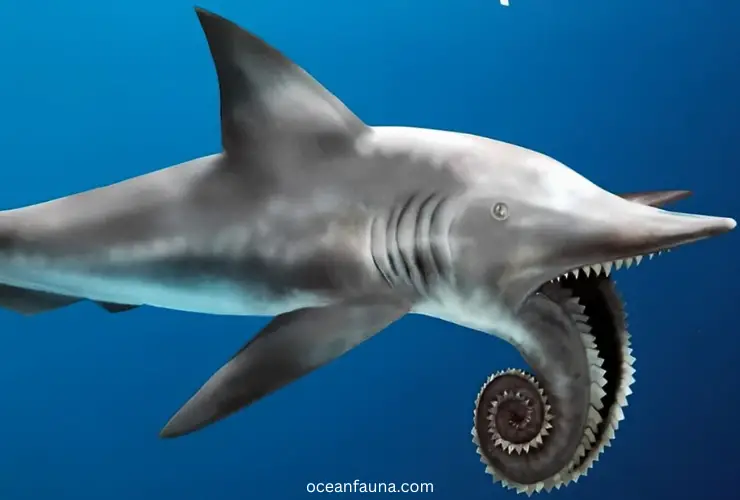
Helicoprion is an extinct genus of sharks that lived around 290 million years ago during the Carboniferous and Permian periods. This shark is well-known for its uniquely shaped spiral tooth whorl that it uses to catch and eat prey.
The tooth whorl of Helicoprion is its most distinguishing feature. This structure is made up of hundreds of teeth that are arranged in a spiral that curves back toward the shark’s throat. The whorl has been observed in several locations around the world, including Idaho, Nevada, and Russia.
Scientists are still unsure of exactly how Helicoprion used its tooth whorl to catch prey. Some theories suggest that the shark may have used its spiral teeth to slash through schools of fish, while others propose that it may have used the whorl to crush shellfish or other tough prey.
Although Helicoprion has been extinct for more than 250 million years, it still fascinates science enthusiasts and paleontologists. The distinctive shape of its tooth whorl has sparked speculation about its hunting and survival strategies, and its fossils offer insights into the evolution of this intriguing species.
Ichthyosaur
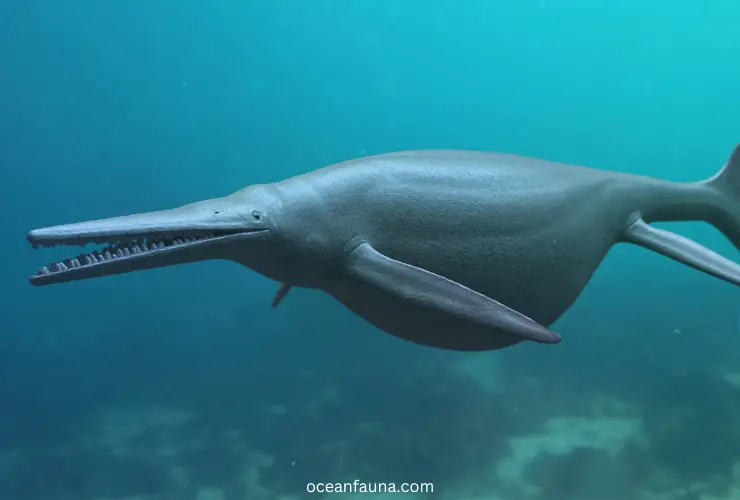
The Ichthyosaur was a giant ocean reptile that lived during the Mesozoic Era. It ruled the oceans for over 150 million years. This animal was not a dinosaur but rather belonged to a group of reptiles known as the ichthyosaurs.
These magnificent creatures ranged in size from less than a meter to over 3 meters long, making them one of the largest marine predators of all time. Their streamlined bodies allowed them to swim quickly through the water. Their long jaws were filled with razor-sharp teeth for catching fish and other prey.
Ichthyosaurs had a special adaptation in their eyes that enabled them to see in low light conditions, which gave them an advantage while hunting in the deep waters. Moreover, they could control their body temperature, which aided them in surviving colder oceans.
Fossils of the ichthyosaur have been found worldwide, from Europe to South America. Some of the most well-preserved specimens have been discovered in Germany, where they are often found with their last meal still in their stomachs.
Although ichthyosaurs were impressively large and adapted to their environment, they became extinct approximately 90 million years ago. Climate change and competition from other marine predators, like the mosasaur, may have played a role in their extinction. Nevertheless, their fossilized remains are still fascinating to both scientists and the general public, providing insight into the ancient underwater world.
Kronosaurus
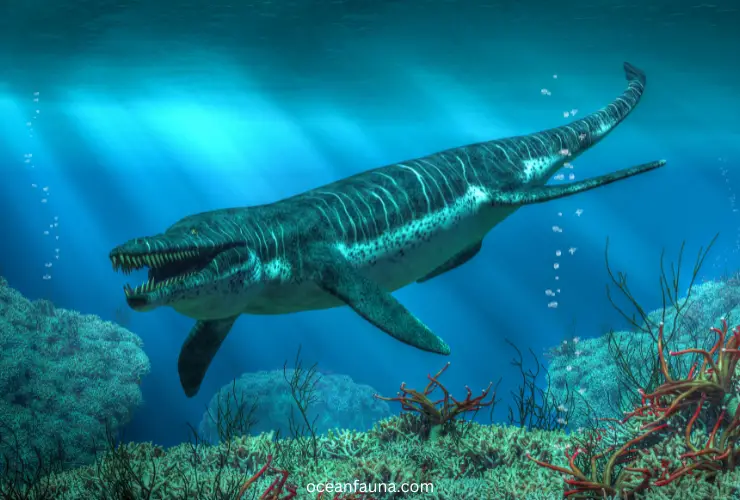
Kronosaurus is an extinct marine reptile that lived approximately 120 to 90 million years ago during the Late Cretaceous period. This prehistoric sea creature was an apex predator that could grow up to 30-36 feet long, making it one of the largest marine reptiles ever to exist.
Kronosaurus had a massive head almost one-third of its body length, equipped with sharp teeth up to 10 inches long. Its jaws could generate a bite force of over 33000 PSI, which allowed it to easily prey on large marine animals such as turtles, plesiosaurs, and even other marine reptiles.
To facilitate swimming, Kronosaurus had a streamlined body shape and four powerful flippers that could propel it through the water with incredible speed and agility. Due to its large size and powerful swimming abilities, Kronosaurus would have been the dominant predator in its marine ecosystem.
The fossils of Kronosaurus were first discovered in Australia in the late 1899s, and since then, numerous fossils have been found throughout the world, including Europe, South America, and Antarctica. Scientists believe that Kronosaurus went extinct along with the dinosaurs at the end of the Cretaceous period due to a combination of environmental change and competition from other marine predators.
Leedsichthys
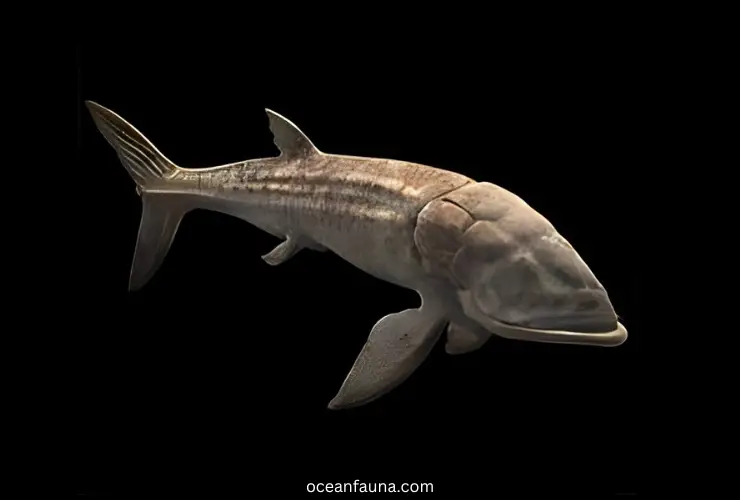
Leedsichthys was a type of giant fish that is no longer alive and existed during the Middle to Late Jurassic period, around 155 to 140 million years ago. Belonging to the family Pachycormidae, Leedsichthys was one of the largest bony fish ever to exist, with estimates ranging from 16 to 22 meters (52 to 72 feet) in length and up to 45 tons in weight.
Their fossils were first discovered in the early 19th century in England and were named after the city of Leeds. Since its initial discovery, several almost complete skeletons have been found in Europe and South America, providing valuable insights into the anatomy and biology of this prehistoric giant.
Leedsichthys had a distinct way of feeding that set it apart from other bony fish. Instead of teeth, it had long gill rakers that were likely used to filter food from the water. These fish are thought to have primarily eaten plankton, which was plentiful during the Jurassic era.
Leedsichthys was also a fast swimmer with a streamlined body shape well-adapted for swimming in open water. It probably migrated long distances in search of food and may have been capable of diving to great depths.
Despite its enormous size, Leedsichthys was not at the top of the food chain. Fossil evidence suggests that it was preyed upon by large marine reptiles such as ichthyosaurs and pliosaurs.
Liopleurodon
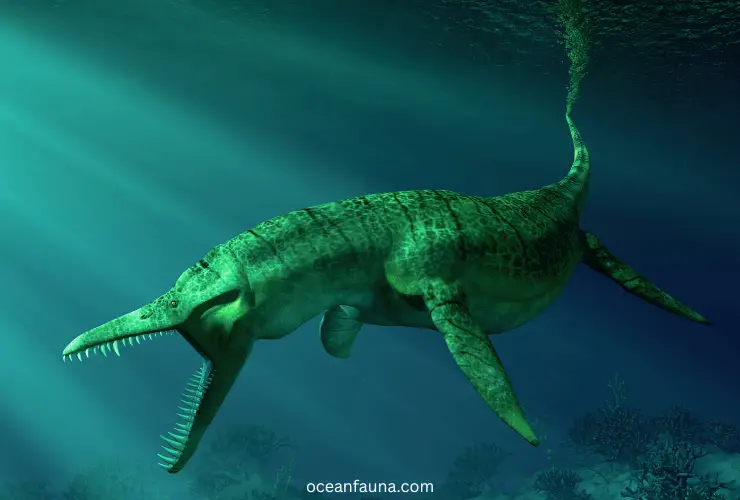
During the Jurassic period, around 160 million years ago, Liopleurodon was a huge marine reptile and a dominant ocean predator. The largest species of Liopleurodon known to us could reach up to 22 feet in length, making it one of the largest predators of its time.
Liopleurodon was a member of the Pliosauroidea group of plesiosaurs, which were characterized by their large heads and short necks. The creature’s name means “smooth-sided tooth,” which refers to the smooth surface of its teeth. These teeth were long and pointed, perfect for catching and holding onto prey.
Scientists believe that Liopleurodon was an apex predator, meaning that it was at the top of the food chain in its environment. The creature likely fed on a variety of marine life, including fish, squid, and even other smaller plesiosaurs.
Despite its scary look, Liopleurodon is not considered a fast swimmer. Instead, its large size and strong jaws were used to ambush prey, similar to how crocodiles hunt.
Liopleurodon is known from fossil specimens found in England and France and is considered one of the most impressive and fearsome predators that ever lived. While we may never know all the secrets of this ancient marine reptile, the fossils that have been discovered continue to provide us with a glimpse into the past and the incredible animals that once roamed the earth.
Megalodon
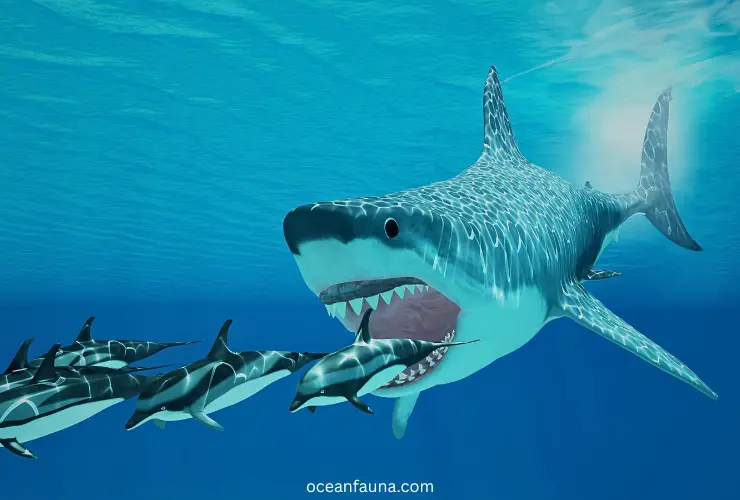
Megalodon was a prehistoric shark that existed around 2.6 million years ago in the Cenozoic Era. It was one of the largest predators to have ever lived on earth, with an estimated length of up to 18 meters and weighing around 50-60 tons. Megalodon’s teeth were the most impressive part of its anatomy, as they were massive and serrated, allowing it to bite through the toughest of prey.
Megalodon was known to be a formidable hunter, preying on whales, dolphins, and other large marine animals. Its hunting technique was unique, as it would swim up from the depths of the ocean and deliver a powerful bite to the prey’s underside, crippling it and making it easier to hunt.
Despite its fearsome reputation, the megalodon is no longer alive, and we can only learn about the creature through fossils. Scientists think that changes in ocean temperature, sea levels, and competition from other marine predators possibly contributed to the megalodon’s extinction.
One interesting myth about megalodons is “Megalodons are the ancestor of great white sharks.” However, it is not true. Megalodon and great white sharks both belong to separate families. Megalodon belongs to the extinct family Otodontidae, whereas Great White Shark belongs to the living family Lamnidae.
Mosasaurus
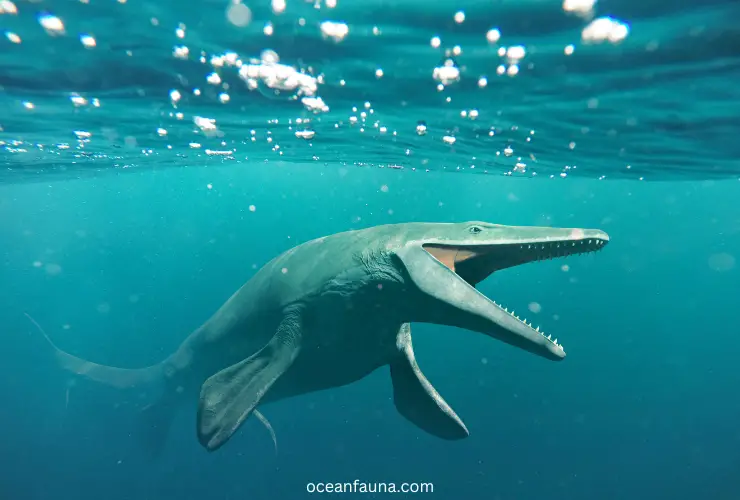
Mosasaurus is a genus of large marine reptiles that lived approximately 145.5 to 66 million years ago during the Late Cretaceous period. They are members of the mosasaur family, which are closely related to modern-day snakes and lizards. The name “mosasaur” comes from the Latinized name of the Meuse River in the Netherlands, where the first described mosasaur fossils were found.
Mosasaurus is known for its large size, with some species reaching up to 36 feet in length. They were also incredibly powerful swimmers and could hunt various prey, including other large marine reptiles like plesiosaurs and sea turtles. Despite their size and strength, Mosasaurus were not dinosaurs. Rather, they were reptiles that lived alongside the dinosaurs during the Late Cretaceous period.
Mosasaurus had powerful jaws that were lined with sharp teeth, which were versatile for tearing through flesh and crushing shells. They had a range of teeth types that adapted to different types of prey, such as conical teeth for grasping slippery prey and bladelike teeth for slicing through tough shells.
Mosasaurus is also known for their unique body shape, with long, streamlined bodies and flattened tails that allow them to move easily through the water. Their limbs were modified into flippers, which were well-suited for swimming but not for walking on land.
Nothosaurus
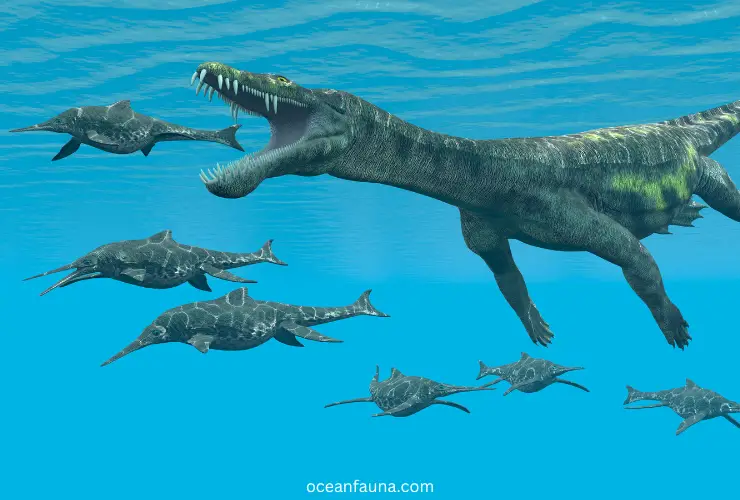
Nothosaurus was a prehistoric marine reptile that lived approximately 240 million years ago during the Triassic period. Its name means “false lizard,” as it was originally thought to be a type of lizard before its true nature was discovered.
This reptile belonged to a group known as the Sauropterygia, which includes other famous species such as Plesiosaurus and Ichthyosaurus. Nothosaurus had a long, streamlined body and four flippers that it used for swimming. Its jaws were lined with sharp teeth, indicating that it was a carnivorous predator.
Nothosaurus was a relatively small species, reaching lengths of only 5-7 meters. However, its small size did not make it any less dangerous. Nothosaurus was a fast and agile swimmer, able to chase down its prey with incredible speed.
Nothosaurus was also an important evolutionary ancestor of other marine reptiles. Its fossils have been found all over the world, from Europe to Asia to North America. Scientists have used these fossils to learn more about how these reptiles evolved and adapted to life in the sea.
Plesiosaur
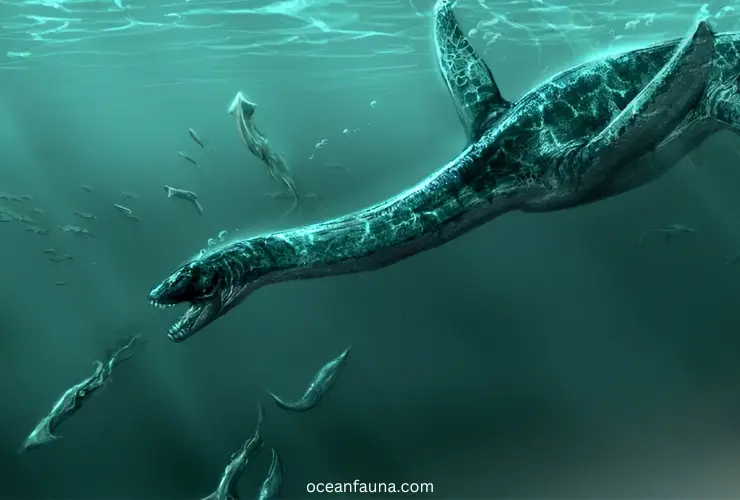
The Plesiosaur was an ocean reptile that existed from 215 to 66 million years ago, spanning from the late Triassic to the late Cretaceous period. It is one of the most recognizable prehistoric creatures due to its long neck, four flippers, and a streamlined body.
The Plesiosaur is commonly depicted in popular culture as a ferocious sea monster, but in reality, it was a relatively small predator that fed on fish, squid, and other small prey.
The Plesiosaur was first discovered in the 19th century by a British paleontologist, Mary Anning. Since then, numerous specimens have been found all over the world, ranging from a few feet to over 50 feet long. The Plesiosaur’s long neck was a remarkable adaptation that allowed it to catch prey easily. Its neck contained over 70 vertebrae, which is more than any other vertebrate animal known to science.
Another interesting fact about the Plesiosaur is that it had one of the largest brains of any marine reptile. This suggests that it was highly intelligent and had advanced sensory capabilities. The Plesiosaur’s four flippers were also unique among marine reptiles, as they were used for propulsion rather than steering.
Tylosaurus
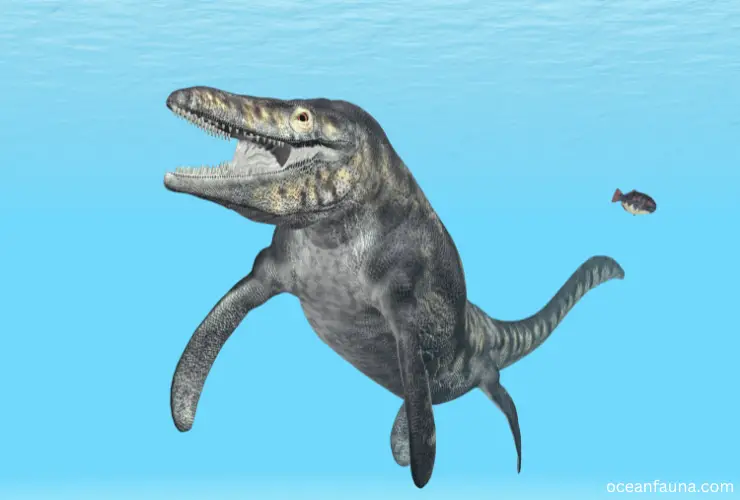
Tylosaurus is a genus of large marine reptiles that lived during the Late Cretaceous period, approximately 85 million years ago. It was one of the largest predators of its time, growing up to 15 meters (49 feet) in length and weighing over 7 tons. The name Tylosaurus means “knob lizard,” referring to the large bony bumps on its skull.
Tylosaurus was a type of mosasaur, a group of marine reptiles that were closely related to modern-day snakes and lizards. Like all mosasaurs, Tylosaurus was a powerful swimmer with a long, streamlined body and a powerful tail. Its flippers were modified into paddle-like structures that helped it maneuver through the water.
One of the most distinctive features of Tylosaurus was its toothy jaw. It had over 80 sharp, cone-shaped teeth that it used to snatch prey such as fish, squid, and smaller marine reptiles. In fact, some fossilized remains of Tylosaurus have been found with the skeletons of other mosasaurs in their stomachs, suggesting that they may have been cannibalistic.
Although Tylosaurus was a formidable predator, it was not invulnerable. The large marine reptile faced threats from other predators like sharks and Kronosaurus. Furthermore, alterations in the earth’s climate and food resources resulted in Tylosaurus and numerous other marine reptiles becoming extinct after the Cretaceous era.
In present times, Tylosaurus is known from a large number of fossil specimens found in North America, particularly in areas that were once covered by the Western Interior Seaway, a shallow sea that covered much of the continent during the Late Cretaceous period. Its striking appearance and enormous size have made it a popular subject of study and fascination for scientists and the public alike.
Conclusion
Hopefully, you enjoy the detail on all the 15 prehistoric sea creatures. If you want to know more about any specific sea creature and its history, then you should read more about it.
Also, you may contact us, keeping your question. I must answer them as soon as possible.

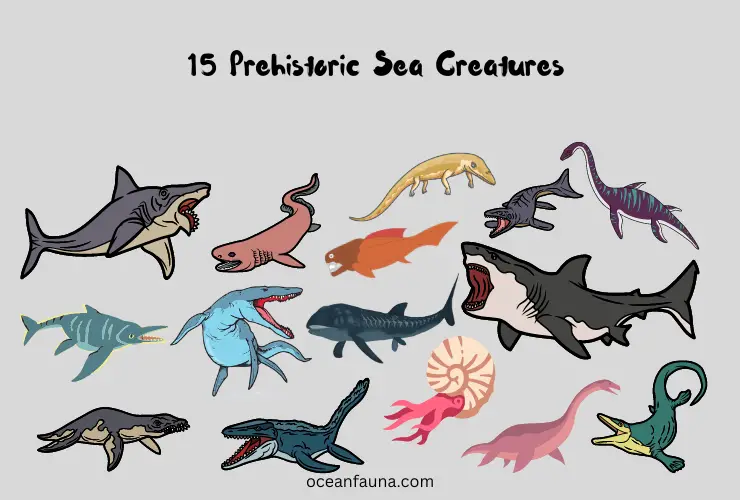
5 thoughts on “Top 15 Prehistoric Sea Creatures: Discover from Bio History”